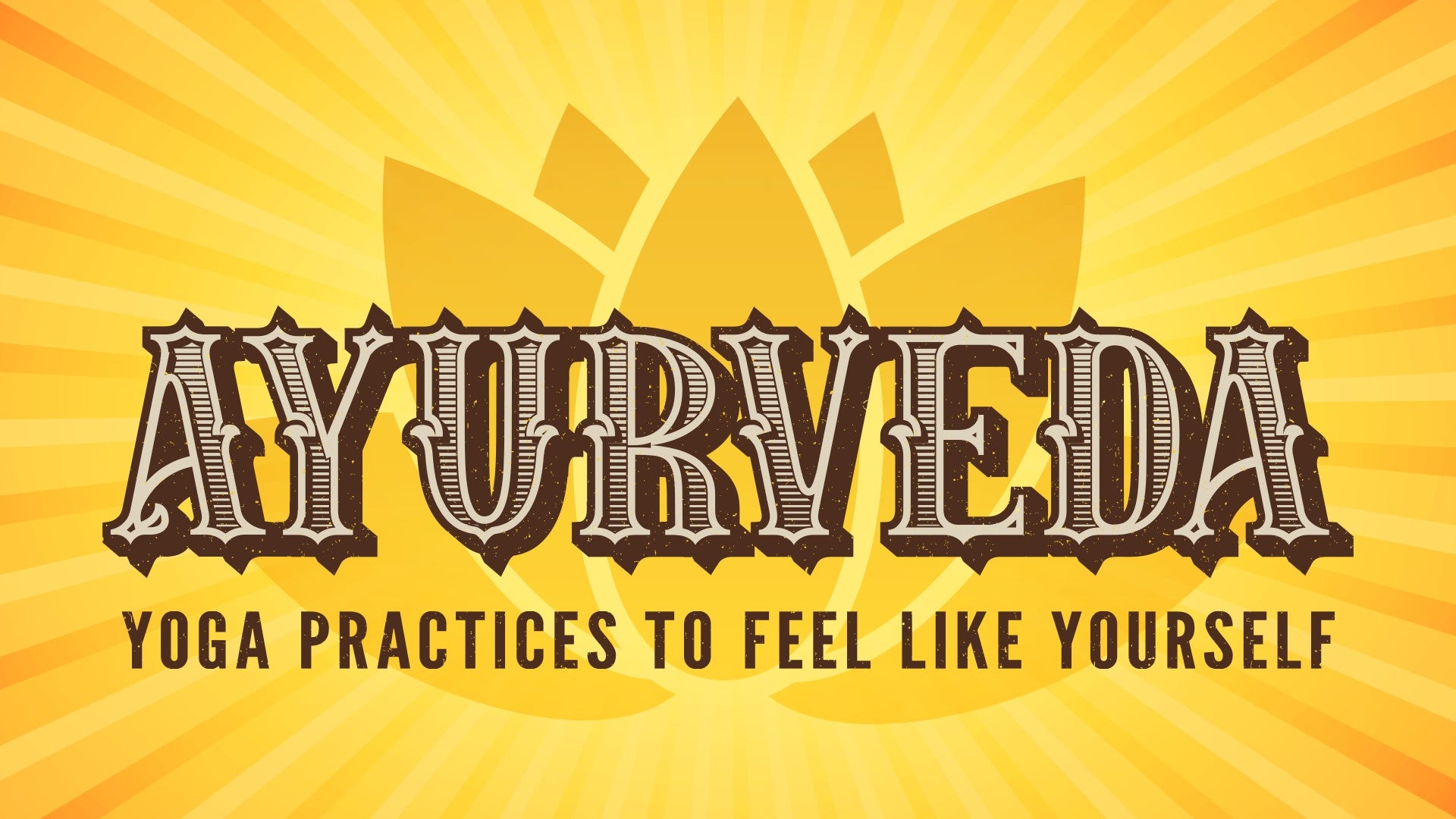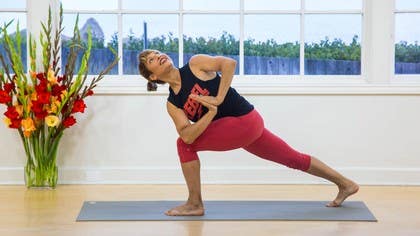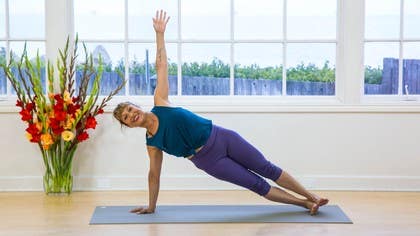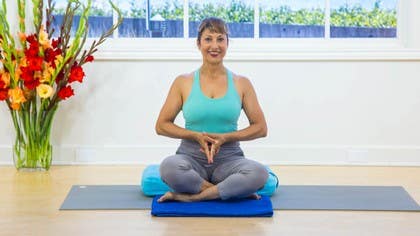Description
About This Video
Transcript
Read Full Transcript
Namaste. For this we're going to be doing a pranayama practice. So in the physical practices that related to the values, we had an opportunity to feel the way that these different energies play out in our bodies. And so this is going to be a more extended version of the breath practices and mudras that we started off. So this would be a beautiful subtle practice to try after your physical practice or if in the morning it's a day where you just want something a little bit quieter or also right after work.
If you feel like you need a reset, this would be a great practice for that. We're going to start in Sukhasana. Make sure you have a comfortable seat because I am going to lead you through five different practices and then we're going to end in Sukhasana. So really give this an opportunity to land in the body. I'm sitting on a bolster with a blanket underneath my ankles to make it soft.
So feel free to take blocks, blankets, whatever it is for you to sit comfortably. And we're going to start off with Udana Vayu. My thought for this practice was to start from the top and work our way down to have this idea of getting the inspiration and the energy moving through the crown of the head and then also being able to bring it down so that it feels very grounding as well. And we'll start with Venus Mudra. So interlace your fingers and press the index fingers together across the thumbs and place that right underneath the chest so you have some free movement for your breathing.
And the pranayama practice that we'll be doing with this mudra is called Ramari and that means bumblebee. So you're going to breathe in through your nose and then as you breathe out through your nose, keeping the lips close, there's a gentle humming and it stimulates the throat, stimulates the fifth chakra, very good for the thyroid and extremely soothing for the nervous system. So we'll start a couple rounds together, breathing in and then humming on the breath out. Again, breathing in and humming on the breath out. Breathe in and hum on your breath out.
Breathing in, breathing out. Two more times, breathe in and hum on your breath out. Last time, breathe in. And at the end of that last breath, release the mudra, turn the palms upright on the thighs and just have a moment to feel. Each of these pranayama practices can also be isolated.
I find brahmari breath to be a very useful tool as soothing for vata and good for the thyroid for kappa. People usually don't have trouble speaking up, but if you do, this would be a great practice for you. And our next practice as we work our way down the body will be for pranavayu. For this, we're going to be working in pran mudra, which is an energy charging mudra and you just take the middle fingers and the ring fingers of each hand into the thumb and hands can go upright on the thighs. And for this, we're going to be working with antarakumbaka because pranavayu rules our inhale.
It's the energy that brings breath in and up and it lives in the heart. So we'll use the retention on our inhalation, antarakumbaka. So take a slow, deep breath in through the nose, let the belly fill and retain your breath. And then gently breathe out also through the nose. And then again, breathing in, let the belly fill and retain the breath in.
Let it circle around the heart. And gently breathe out. One last time, breathing in. Breathe in, breathe in, breathe in. And gently breathe out and then you can release your mudra and just let your hands rest upright on your thighs.
You might even close the eyes and take the internal gaze down towards your heart. One of my teachers used to say, if you're feeling closed off or you're having trouble getting in touch with your devotion, to use this breath and then afterwards to close the eyes and take the energy right into the chest. And then you can open up the eyes. You might give your legs a little bit of a shake out. And then re-cross in the opposite direction.
Our next practice is going to be breath of fire, which is exactly what it sounds like. It's a heating breath. It's energizing. Definitely get some manavayu going right here at the belly. It is good, especially good for the morning.
If you're feeling a little constipated, a little stuck, and you want to get that digestive fire, that agni going. This is a great practice to start your day off with. It is a very heating breath, as I mentioned. So ladies, if you're pregnant or on the first day or so of your cycle, you might choose to skip this one. You can definitely do the mudra with us, but perhaps just staying with long, smooth breathing.
We're going to work with pushan mudra, which is a mudra of nourishment. Take the index finger and the middle finger of the right hand and press them to the thumb. And then the middle finger and the ring finger of the left hand and press them to the thumb. And you can place that upright on your thighs. Take a breath in, breathe everything out, and then moving right into the belly.
While halfway, begin your round of breath of fire. One, two, three, four, five, six, seven, eight, nine, eight, nine, eight, nine, eight, nine, eight, nine, eight, nine, eight, nine, eight, nine, eight. And breathe in, and breathe out. And then just feel that definitely raised my temperature a little bit. So a good thing to keep in mind with breath of fire, you might have heard that a yogi's life is a certain amount of breath.
And then why would we ever do breath of fire? Why would we speed that up? My Kundalini teacher says that in breath of fire, it's actually only counting as one breath because the impulse on the breath only happens once. You have the impulse to breathe and then it just goes. So it's actually a life extender.
You can release the mudra, give your hands a little shake, be there for a moment. And so keeping that in mind, let's try one more round. And please, if it feels like too much, feel free to stop anywhere along the way, especially if it's newer for you. One more time. Breathing in.
Breathing out. And inhale halfway, begin. Breathing in. And slowing down. And breath in.
And breath out. And then just be there. And you can release your mudra. And now we're going to move on to Upana Vayu, that downward moving energy. Getting into the pelvis area, and this helps to govern elimination.
For ladies, this is your menstrual cycle, or if you're having a baby. And this Vayu helps to make us feel grounded and connected to the earth. You'll start with Ksapanamudra. You hear the word Upana in there, downward moving energy. Interlace the fingers, press the index fingers together, cross the thumbs.
It's very much like the Venus mudra, but this time instead of the energy moving up for Udana, we're moving down for Upana. And for this one, we're going to be doing Baya Kumbhaka, which is a retention on the exhalation. And the idea with the retention on the exhalation is to tap into our sense of trust in letting go, trusting that the next breath is there for us when we need it. So let's breathe in together through the nose, breathe out through the nose, and at the bottom of the exhalation, hold the breath out, hold it out. And breathe in, breathe out.
Again like that, breathe in through the nose, and breathe everything out. And hold the breath out at the bottom, hold it out. And breathe in, and breathe out. And then last time with that, inhale deeply, and breathe everything out. Totally empty, totally empty.
Every last bit of breath, hold it out. And breathe in, breathe out. Release your mudra, and just take a moment to feel. And then one more time, give your legs a little bit of a shake out. And then re-cross again in the opposite direction.
And our last panayama practice relates to Vyana Vayu, which is the energy that circulates through the body and controls circulation. So we're going to start off in Lotus Mudra, and just have a moment there in this great opening. It's like a flowering, moving energy throughout the body, instead of staying closed off or choosing to open up. And then you can release that mudra, and we'll start to move into Sufi circle. So inhaling forward and around, exhaling back and around, inhaling forward and around, and exhaling back and around.
And stay with that. And if you want to let the eyes close, the eyes can close. If the head wants to follow the lines of the body and kind of turn around on the neck, you can do that. Just let it feel good. And coordinating the breaths, you inhale forward and around, and exhale back and around.
Inhale forward and around, and exhale back and around. Last few times. And then come back into center. Let some of that settle. And then change the crossing of the legs, and let's take it in the other direction.
Counterclockwise, inhaling forward and around, and exhaling back and around. You might feel the weight transferring from hip to hip, and the knees can move, the body can move. With this particular practice, the whole body can move. Working with it. And last three or four.
Depends on your pace. And always feel free to go a little faster, a little slower. Staying with the practice. And then last time, and right around to the middle. You might bring your hands back into Lotus Muja for a moment.
Just let yourself be breathed for a moment. What Pranayama does is that it moves our energy from the back of our brain, from our instinctive animal brain, and brings it forward into the space in the brain that is responsible for higher thinking, higher consciousness. The part of our brain that wants to be inspired and imaginative. It's a powerful, powerful practice. Let your Muja go.
And let's come to rest in Shavasana and just let the body absorb the effects of this. So you've got a bolster. You can place the bolster underneath your knees. You might take your blanket if you've got a blanket. And fold it just non-fringe to non-fringe.
Make a little pillow for your head. Bolster right at the crook of the knees. So nice. And then lowering yourself down. So coming down to lie down with the blanket beneath your head.
And see if you can take the edge of the blanket, the smooth edge of the blanket, to C7, which is that little knobby vertebra that pops out there at the base of the neck. Fill up the gap of the cervical spine. Let the arms rest by the sides. And then just release any knee to control the breath at all. Let yourself be breathed here.
And it's such a beautiful affirmation of yoga, of the union between our human self and our divine self. Breath is the only function in the body that is both conscious or unconscious. It can be either. So we don't need to control it, and yet we're still sustained. Better.
Thank you. Thank you. And then take a deeper breath in, deeper breath out. Take some little movements with your fingers, with your toes. Walk the soles of your feet in. You can let them rest on your bolster or if you have a blanket there or just on the ground.
And roll over onto your right side. And you can use the arms to come on up to sit. It really is such a reset for the entire system to balance out these five different energies. I hope you enjoyed your pranayama practice. Namaste.
Ayurveda: Practices to Feel Like Yourself: The Vayus
Comments
You need to be a subscriber to post a comment.
Please Log In or Create an Account to start your free trial.










